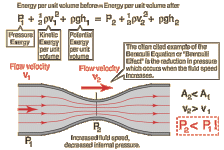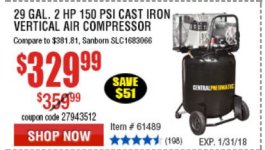I (and you're free to differ) believe there is an advantage to larger diameter line even if the inlet is smaller, in that the line is part of the 'tank' and puts a larger volume of storage closer to the tool, not a lot, but in burst operation a long line of small diameter can create more resistance than just a small restriction due to the storage effect, more air closer to tool w/ less restriction in line.
This might be something for a 'MythBuster' analysis LOL
I'm no engineer, but until one chimes in, I think the answer lies with two separate principles: (1) loss of energy due to friction against the walls of the hose or fitting, and (2) the Bernoulli Effect, which says that an increase in the speed of a fluid (either liquid or gas) through a constricted space is simultaneously accompanied by a decrease in the fluid's pressure, i.e., its potential energy.
Energy loss due to friction: The friction coefficient of the hose or fitting is affected by the size being used. Increasing the internal diameter of a hose or a fitting by just 25 percent (e.g., switching from 3/8" I.D. hose to 1/2" I.D.) nearly doubles the internal volume of air that the hose/fitting will handle (cfm) at a given pressure. So the airflow encounters less resistance per unit of volume, and there is less friction loss.
Energy loss due to the Bernoulli Effect: Assuming the compressor is delivering a constant psi, when the air encounters a restriction due to a smaller hose or the smaller orifice of a fitting, it will speed up. Because of the Bernoulli Effect (which derives directly from the principle of conservation of energy), the air pressure must simultaneously drop until past the restriction, reducing its potential energy to drive the pneumatic tool.

In the case of fittings, I've used the larger-style fittings linked to earlier (
1/4 In. x 3/8 In. Automotive Series Coupler and Plug Kit 4 Pc) on 3/8" hoses for about 20 years, although mine came from Home Depot under, I think, the Campbell-Hausfeld brand. From experience, they make the higher-volume pneumatic tools work noticeably better. As California noted, the I.D. of the larger HF fittings is 7.5mm, vs 5mm for the standard. That's a full 50 percent increase!
I've never needed to go with 1/2" hose, and would be reluctant to do it because of the weight and stiffness. 3/8" hoses are cumbersome enough to handle. If I were removing lug nuts on heavy equipment all day, I would for sure!

